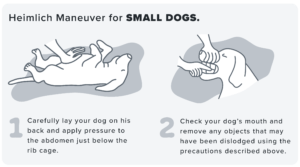April is National Pet First Aid Awareness Month – a month dedicated to educating pet parents on pet care tips during an emergency.
In this blog, you’ll find out exactly what to do, and what not to do, in case of an emergency with your pets. Your knowledge and prompt response could save your furry companion’s life. So, take note of what you are about to learn and be prepared should a pet emergency occur when a vet’s not around the corner to assist.
Emergency 1: Pet CPR
So, Sandy is not a strong swimmer. But she accidentally slips into the pool and struggles to stay afloat. You immediately start to panic and jump straight in to rescue the wet ball of fur. Once you’re out of the water, you notice that she has trouble breathing. Oh no! What now?!
What NOT to do:
Don’t panic and rush him/her to the vet. There’s no time to waste, as a dog or cat can only live for up to 6 minutes without oxygen. Rather act fast and apply CPR.
What TO do:
Do CPR immediately! “Perform chest compressions with blowing into the nose intermittently”, says Dr Yecintha Naidoo, a vet at the Ridge Vet & Spa in Umhlanga.
PetMD provides the following pet CPR guidelines:
CPR for dogs and puppies weighing less than 14 kg:
- Lay the dog on his/her side (either is fine) on a flat surface.
- Place one hand on either side of the chest over the heart region. (You can also place your thumb on one side of the dog’s chest and keep the fingers on the other side if the dog is very small.)
- Compress the chest approximately one-third the width of the chest for a count of one, and then let go for a count of one. Carry on at a rate of 100-120 compressions per minute.
- If you can provide artificial respiration, close the dog’s mouth with your hand. Give two breaths into the nose for every 30 compressions. If possible, have another person give the two breaths so that you can continue to do compressions while they do the breathing. A new person should take over doing the compressions every 2 minutes or so to reduce the effect of fatigue.
- Continue with the CPR and artificial respiration for dogs until the dog begins breathing on his own and the heartbeat returns.
- Transport the dog to the nearest veterinarian as quickly as possible during or after CPR.
CPR for medium/large dogs over 14 kg:
- Lay the dog on his/her side (either is fine) on a flat surface. You will need to stand or kneel beside the dog. For barrel-chested dogs like Bulldogs, it is also appropriate to place the dog on his/her back.
- Place one of your palms on the dog’s rib cage, over the heart region, and put your other palm on top of it.
- Without bending your elbows, press the rib cage down.
- Compress the chest one-third the width of the chest for a count of one, and then let go for a count of one. The rate should be 100-120 compressions per minute.
- If you can provide artificial respiration, close the dog’s mouth with your hand. Give two breaths into the nose for every 30 compressions. If possible, have another person give the two breaths so that you can continue to do compressions while they do the breathing. A new person should take over doing the compressions every 2 minutes or so to reduce the effect of fatigue.
- Continue performing CPR and rescue breaths until the dog begins to breathe and a heartbeat returns.
- Transport the dog to the nearest veterinarian as quickly as possible during or after CPR.
Emergency 2: Troubled ticks
Wait, is that a bloodsucking parasite you see on Bella’s back?
What NOT to do:
Dr Naidoo advises not to pull a tick off, because parts of it might break off and remain lodged inside your dog.
What TO do:
“Purchase an over the counter Tick n Flea product such as Bravecto/Nexgard or Frontline etc. If your pet shows symptoms of not being well such as lethargy etc. – seek veterinary advice.”, Dr Naidoo explains.
Emergency 3: Chocking hazard
You threw Bruno a bone and suddenly you notice that he’s making strange noises that sound like he’s chocking. How do you help your hound?
What NOT to do
You shouldn’t have given your dog a bone in the first place. “Bones are not digested properly and may cause gastric upsets or obstructions”, says Dr Naidoo.
What TO do
If your dog swallows a bone by accident and chokes on it. Do the following:

Always make your pet’s safety a priority. As a precautionary measure, save your local (and also a mobile) vet’s emergency contact details on your phone. If you are unsure what to do in a pet emergency, and you are travelling and/or not near a vet practice, you can still contact your local vet for emergency advice. He/she will guide you with the best possible course of action and recommended treatment.
Remember that dotsure.co.za covers the emergency vet bills if you take out a pet insurance policy*.
Quote and buy pet insurance online in less than 5 minutes!
Related articles:
Pet Health: Here’s the scoop on kitty poop.
6 Important pet fire safety tips
Stop these parasites from killing your pets!



